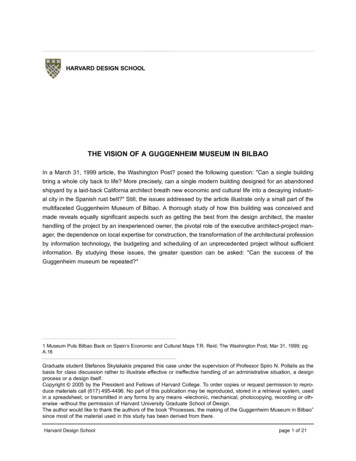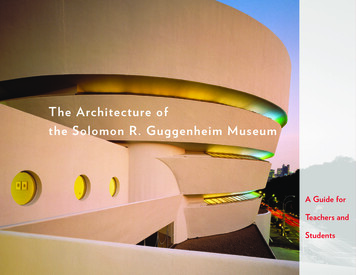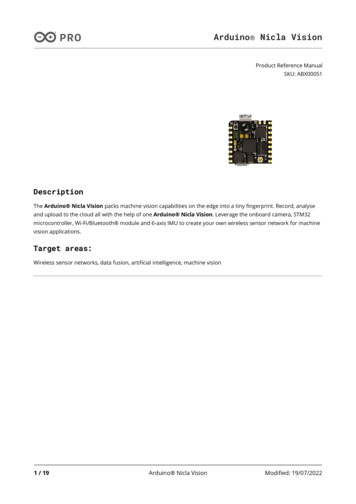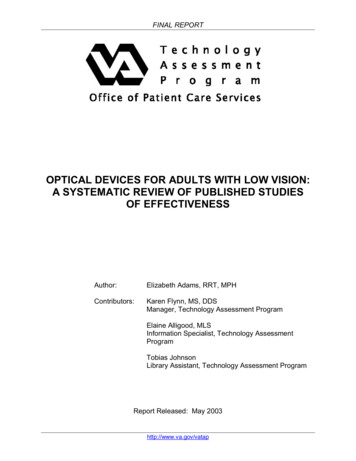
Transcription
HARVARD DESIGN SCHOOLTHE VISION OF A GUGGENHEIM MUSEUM IN BILBAOIn a March 31, 1999 article, the Washington Post? posed the following question: "Can a single buildingbring a whole city back to life? More precisely, can a single modern building designed for an abandonedshipyard by a laid-back California architect breath new economic and cultural life into a decaying industrial city in the Spanish rust belt?" Still, the issues addressed by the article illustrate only a small part of themultifaceted Guggenheim Museum of Bilbao. A thorough study of how this building was conceived andmade reveals equally significant aspects such as getting the best from the design architect, the masterhandling of the project by an inexperienced owner, the pivotal role of the executive architect-project manager, the dependence on local expertise for construction, the transformation of the architectural professionby information technology, the budgeting and scheduling of an unprecedented project without sufficientinformation. By studying these issues, the greater question can be asked: "Can the success of theGuggenheim museum be repeated?"1 Museum Puts Bilbao Back on Spain’s Economic and Cultural Maps T.R. Reid; The Washington Post; Mar 31, 1999; pg.A.16Graduate student Stefanos Skylakakis prepared this case under the supervision of Professor Spiro N. Pollalis as thebasis for class discussion rather to illustrate effective or ineffective handling of an administrative situation, a designprocess or a design itself.Copyright 2005 by the President and Fellows of Harvard College. To order copies or request permission to reproduce materials call (617) 495-4496. No part of this publication may be reproduced, stored in a retrieval system, usedin a spreadsheet, or transmitted in any forms by any means -electronic, mechanical, photocopying, recording or otherwise -without the permission of Harvard University Graduate School of Design.The author would like to thank the authors of the book “Processes, the making of the Guggenheim Museum in Bilbao”since most of the material used in this study has been derived from there.Harvard Design Schoolpage 1 of 21
Guggenheim Museum in BilbaoBILBAOBilbao is an urban region of approximately 41-square-kilometers located on the Atlantic coast of NorthernSpain. It is the principal city of Spain's Basque minority with a population of 400,000 but encompassing ametropolitan area of about 1 million people. Its population is distributed between thirty municipalities ofwidely disparate populations. Only six of these municipalities exceed 50.000 inhabitants: Bilbao,Barakaldo, Getxo, Portugalete, Santurtzi and Basauri. The Metropolitan Bilbao area is the fifth most populous, behind Madrid, Barcelona, Valencia and Sevilla. It is the 36th largest city in Europe, similar in sizeto Dublin, Liverpool and Florence. The city dates back to 1300. According to the London Financial Times¹,it is one of Spain's major ports and has been the entry point for heavy manufacturing into Spain for 100years. Fishing and other industries, including chemicals and metallurgy are also important. Up to the1970s Bilbao was still the wealthiest part of the country, until it suffered a major blow in the late 1980swhen its big downtown shipyard closed because of low-wage competition from Eastern Europe and Asia.A city which has pockets of 35% unemployment and which has grown used to seeing riot police, was hardly known as a center of the leisure industry, except perhaps by merchant seamen. The new GuggenheimMuseum has boosted the local economy, helping to create 3,800 jobs and new tourism revenue.The Guggenheim Museum Bilbao was a key component of the Revitalization Plan for Metropolitan Bilbao²,a huge renewal strategy in the heart of a region whose economic support had become outdated. TheRevitalization Plan for Metropolitan Bilbao aimed to transform the city into a service metropolis within amodern industrial region in the European arena.Bilbao's economy placed a modest 56th among European cities in 1973³. In 1992, Bilbao missed beingpart of the Spanish regeneration wave, when Barcelona hosted the Olympics, Seville the World Exposition,and Madrid became the European Capital of Culture. Considered one of the least glamorous amongst the15 Spanish regional capitals, the economy of the region was severely depressed in the eighties by thedecline of the steel industry and the emerging competition in heavy manufacturing from 'tiger economies'of Southeast Asia.Bilbao Metropoli 30 was formed in 1989 as a public and private institution, in order to prepare BilbaoMetropolitan Revitalization Plan. The plan included eight critical strategies: Invest in Human Resources ofthe Region, Create a Service Metropolis in a Modern Industrial Region, Improve Mobility and Accessibility,Regenerate the Environmental, initiate Urban Regeneration, Develop Cultural Centrality, promoteCoordinated Management by the Public Administration and Private Sectors, and promote Social Action.The plan represented a unique combination of efforts. José Antonio Garrido, Chairman of he Associationfor the Revitalization of Metropolitan Bilbao (Metropoli -30) explains: "When I accepted the Chairmanshipof the Association for the Revitalization of Metropolitan Bilbao, I was inspired by the scope and content of1 “Financial Times (London)”; May 27, 1997.2 More information about the Revitalization Plan for Metropolitan Bilbao can be found on the upcoming book “Processes,the making of the Guggenheim Museum in Bilbao”.3 Techniques et Architecture. Dec. 1997-Jan. 1998. n435.p 19-25Harvard Design Schoolpage 2 of 21
Guggenheim Museum in Bilbaoits mission: to bring together public institutions and private enterprises who wanted to realize a commonobjective - the revitalization of Metropolitan Bilbao."There were more construction projects in the revitalization plan beyond the Museum. Among the most visible are the new Bilbao Metro railway, designed by Foster and Partners; a new terminal for the airport andthe new "Zubi Zuri" (white bridge) footbridge over the Nervion at a short distance upstream from the museum, both by Santiago Calatrava; a railway station, the "Abando Passenger Interchange," designed byMichael Wilford (not built); and a 25,000 m2 music hall, the "Euskalduna Juaregia Bilbao," by DoloresPalacios and Federico Soriano. Precisely because of its scale and ambitions though, the revitalization planwas met with local excitement, but critical skepticism too as the costs involved were high by any measure.The new museum alone required an investment of over 10,000 million pesetas ( 95.24 million USD)¹.It is important to mention that the Basque region is responsible for raising its own taxes, and the BasqueNational Party (PNV) had a controlling majority in the Basque Parliament at that time. These two politicalfactors alone facilitated rapid decision-making, at least in the case of the museum. The revitalization planraised 20 billion pesetas of public investment without using Spanish central government funds fromMadrid, with all the money coming from the province of Vizcaya, known in the Basque language as"Bizkaia" where the city of Bilbao is located.THE BASQUE ADMINISTRATION' S COMMITMENTThe new Museum symbolizes the Basque Administration's commitment to enhancing Bilbao's economicstanding and visibility as a cultural center in the European Community. The Guggenheim Museum Bilbaois the result of a unique collaboration between the Basque Administration and the Solomon R.Guggenheim Foundation. The Basque Administration had substantial funds at its disposal: 1.5 billion fora revitalization plan intended to replace its old industrial orientation with a service economy. It was willingto pay 20 million up-front for the Guggenheim name and expertise, 100 million for the building, 50 million for its own acquisitions and a promise of 12 million annually to run it. Further, urban redevelopmentof greater Bilbao, (145 hectares of industrial ruins), is backed by a lobby group, Bilbao Metropoli-30, withmore than 120 institutions and companies.In the October 18, 1997, issue of The Gazette (Montreal), the day before the Guggenheim Museum Bilbaoofficially opened its doors, Thomas Krens, Director of the Guggenheim Foundation is quoted as saying: "Itwas commerce, pure and simple, that brought together the Guggenheim and Bilbao.This is not a cultural project, it's an economic development project". Plans for a new cultural institution forBilbao date to the late 1980's when the Basque Administration began formulating a redevelopment program for the region. The City of Bilbao and the Basque regional government stepped forward and contact-1 Peseta-Dollar exchange rate in 1992: 110.00pesetas 1.00 USDHarvard Design Schoolpage 3 of 21
Guggenheim Museum in Bilbaoed the Solomon R. Guggenheim Foundation in 1991. In December of that year a preliminary agreementwas reached to establish the Fundaciòn Del Museo Guggenheim Bilbao to manage the independent institution for a period that could stretch 75 years.The partnership between the Basque Administration and the Solomon R. Guggenheim Foundation isbased upon complimentary strengths. The Basque Administration brings to the relationship its political andcultural authority and financial resources for both capital investments and capital operating support. TheSolomon R. Guggenheim Foundation manages the museum under the supervision of the Fundaciòn DelMuseo Guggenheim Bilbao. It also offers guidance on the Guggenheim Museum Bilbao's acquisitionsbased on the Foundation's curatorial expertise.THE SOLOMON R. GUGGENHEIM FOUNDATIONAs the twentieth century drew to a close the Solomon R. Guggenheim Foundation was singularly positioned to assemble, analyze and present the key aesthetic achievements of the 20th century. Founded in1937 with a collection that spanned the period from the late 19th century to what was then the most current and radical experiments in abstraction, the Solomon R. Guggenheim Foundation dedicated itself tothe task of continuing and preserving the avant-garde movement. Since its inception it has continuallyexpanded its collections as well as its programming activities, always remaining true to its founding charter - that "art, in its most expansive form, can truly effect change in the world".In the late 1980s, the Solomon R. Guggenheim Foundation (SRGF) was facing serious financial difficulties. The construction of the annex for the Guggenheim Museum on Fifth Avenue in Manhattan, New YorkCity, had largely exceeded budget, and the Guggenheim's second home in nearby SoHo had not yetreturned its initial investment. The recent acquisition of the Panza Collection of minimalist art collectionfor 32 million dollars had left the Foundation with limited cash flow, and its debts were rising.Thomas Krens, Guggenheim's Museum Director, knew that 95% of the Guggenheim's art collection wassitting, un-displayed, in the basement of the museum's famous Frank Lloyd Wright building on FifthAvenue. Krens wanted to take advantage of these tremendous assets, and that is precisely when hedecided to introduce a system whereby the foundation's art collection would be circulated and displayedin a series of museums in various locations. Krens is credited with developing the idea of an international"franchising" system for major museums like the Guggenheim. In such a system, various cities worldwidewould be authorized to build -entirely at their own expense- satellite museums under the direction of theparent institution, in this case, the Solomon R. Guggenheim Foundation."We are defining ourselves in terms of strengths, and architecture is one of our strengths"¹ Krens recalled.For 20 million dollars, the SRGF would lend its brand name and collection to foreign institutions while1 New York Times, December 1991Harvard Design Schoolpage 4 of 21
Guggenheim Museum in Bilbaoretaining overall museum management.The new museum would host five or six exhibitions ofGuggenheim art collections a year, while being able to mount its own, locally curated, shows.With this expansion in mind, Carmen Gonzalez, an SRGF curator for Spanish Art in New York, contactedthe Banco Bilbao Vizcaya (BBV), a private financial institution based in Bilbao regarding the possibility offinancing the museum. The management at BBV felt that the project was beyond their institution's logistical capabilities and redirected it to the Gobierno Vasco. Krens and the representatives of the GobiernoVasco first met in Madrid during February 1991. At the time, Krens doubted the group's ability to make asubstantial offer to fund the construction of a museum in Bilbao.Excerpt from the interview with Mr. Juan Luis Laskurain,Minister of Finance of Diputacion of Biscay at the time of theMuseum's conception. (Oct. 1st, 2001)Mr. Laskurain is commenting on the general question of how itall started.Of course, the question "Why Bilbao?" surfaced fairly quickly. Apossible answer was that perhaps the other possibilities that theGuggenheim Foundation had analyzed had proved impossible.They had tried both Massachusetts and Salzburg, and for differentreasons they had not been able to reach an agreement.Inside Spain, Barcelona and Seville were deeply in the process ofpreparing for the 1992 Olympic Games and for the Expo'92 respectively. Madrid had been nominated European Cultural Capital forthe year.Furthermore, the Guggenheim people said that they did not want tohave "just another museum" in places like Paris or London. Theypreferred to be the only star in a place where they will not need tocompete with an "Eiffel tower." And probably, they also soon realized that the local autonomy, both political and fiscal, and thecapacity to make decisions locally were very important.After two months of negotiation, Krens agreed tovisit Bilbao. During his visit, he planned to make adecision to proceed with the project or terminate therelationship. In Bilbao, he realized that the Basqueauthorities were seriously committed to the museumproject. In fact after some additional discussion,both the SRGF and the Gobierno Vasco concludedthat they didn't want to waste any more time, andthat the project should move ahead quickly. m's brand name, while the initial agreement permitted the start of two parallel processes, afeasibility study to evaluate the project and thesearch for an architect. The deadline to completethese first two steps was December 1991.Krens returned to New York in May of 1991 with a memorandum specifying that the design of the museum must be entrusted to an internationally renowned architect. Two weeks later, he returned to Bilbao withthe Pritzker prize-winning architect Frank Gehry, whom he retained as a consulting expert on site selection.THE DEAL OF THE CENTURYThe July, 1997 issue of Art in America outlines what some people in the art world call "the deal of the century". The new Guggenheim Museum formed part of a remarkably bold urban renewal scheme, conceivedby the Basques in 1989. It was intended to transform this deteriorated port, gravely afflicted by accumulated debts, a 25% unemployment rate, industrial pollution and outmoded steel and iron trades, into a center of clean industries (service, financial and high tech) with important tourist and cultural offerings.Harvard Design Schoolpage 5 of 21
Guggenheim Museum in BilbaoMuch of the redevelopment's financing had yet to be secured (funding sources included the Basqueregional and Biscay provincial governments, the Spanish state, the European Community and local andprivate investors). Granted, local financial resources did exist, (Basque per capita income remains 11%higher than Spain's national average). In addition, Basque officials were planning to secure special taxbreaks from the central government to lure companies to their region.As 1991 drew to a close, the museum "deal of the century" was clinched. According to a binding 20-yearcontract (extendable to 75 years), the Basques would finance the construction and operation of a newGuggenheim Museum to the tune of 100%, even down to the fees incurred by the Solomon R.Guggenheim Foundation to draw up that very agreement. Expenses would be borne 50-50 by the governments of the Basque region and Biscay province, (unlike other new Spanish museum projects, the GMBwould receive no funding from the Spanish state) and Town Hall would contribute the site. Costs includedbuilding construction ( 100 million) plus to-be-determined operational expenses (physical plant maintenance, utilities overhead and salaries). To these were added curatorial and administrative services to beprovided by the Guggenheim Foundation. In addition, Basque administrations pledged 50 million for thenew Spanish and Basque art collection (a sum to be spent over a four-year period, starting in 1994). Whenasked about the rationale for the new collection, Krens claimed the Guggenheim Foundation, "proposed itas an integral part of the original agreement because we think that a museum of this size and scope needsan infusion of fresh vitality". According to Gail Harrity (GMB's project director until recently), its purposewas also, "to distinguish the museum from other newly built museums in Europe which are primarily kunsthalles".The Consorcio Guggenheim Bilbao's (CMG) preliminary investment plan for the Museum was 9,800 Mpesetas ( 93.3 million USD) for the building's construction. This amount included the Executive Architect'sfee estimated at 1,600 M pesetas ( 15.24 million USD); plus 2,600 M pesetas ( 24.76 million USD) forparking and infrastructure, 5,000 M pesetas ( 47.6 million USD) to acquire the art collection and an operational cost of 1,350 M pesetas ( 12.86 million USD) per year¹. (Appendix A, Exhibit B)But by far the most striking aspect of this unique agreement was the deal - a 20 million donation theBasques would pay the SRGF, free and clear of taxes and withholding, in two consecutive yearly installments (in February 1992and 1993), well before the museum would be up and running. Much to the chagrin of Guggenheim representatives, in Spain this payment was quickly - and accurately - dubbed the"rental fee" in reference to the future use of the Guggenheim 's collection and "brand name". Harrity insistsit was instead, "a contribution made in support of the partnership". Indeed, since all other services theGuggenheim Foundation provided would be paid for by the Basques, the gift was certainly a measure ofthe Basques' conviction that the Guggenheim's presence in Bilbao would generate substantial reward. Inreturn, the Guggenheim Foundation would exhibit its collection in Bilbao on a rotating basis for the lengthof the contract. Theoretically, all of the SRGF's estimated 6,000 works would be available for display, withthe exception of the Thannhauser collection and other restricted gift and/or artworks deemed too fragile to1 Peseta-Dollar exchange rate in 1992: 110.00pesetas 1.00 USDHarvard Design Schoolpage 6 of 21
Guggenheim Museum in Bilbaotravel.It was arranged from the outset that the SRGF would "operate and manage" the museum. The contractalso affirmed that, "Solomon R. Guggenheim Foundation's involvement is in an advisory capacity only. Itincludes the following disclaimer, which renders the entire arrangement similar to a standard franchise."SRGF shall have no obligations, legal, financial or otherwise in respect to the ownership of the site,design or construction of the museum, or ownership, lease or operation of the museum except for obligations to provide services pursuant to this agreement and liabilities that cannot be waived by law".Guggenheim Museum Bilbao's study (commissioned by the Guggenheim, paid for by the Basque government and conducted by Gestec, IBS and Peat Marwick) projected an annual income of 1.4 billion pesetas( 14 million at that time). This was based on generous private support and in expectation of healthy attendance, consisting of 24% from the province, 32% from nearby regions and the remaining 44% Spanishand foreign. The GMB's estimated that a multiplying effect on the Basque economy would raise annualspending in the region by 35 million, plus generate 4 million in taxes.Nevertheless, Spain's history of meager private giving and relatively low museum attendance pointed to apossible overestimation of these figures. Moreover, given that private patronage of theaters had been slowto develop in the Basque Country (and in Spain overall), fears were that the government (hence Basquetaxpayers) might be stuck with the bill. Continued flak over the GMB and the terms of the agreementapparently induced Basque politicians to negotiate important cautionary clauses in the management contract on December 21, 1994. In an attempt to ensure the exclusivity of Bilbao's museum, the agreementput the brakes on Guggenheim expansion in Europe by requiring Basque consent on any satellite.To guarantee that Bilbao would enjoy sufficiently high-quality programming, the contract asks that theSolomon R. Guggenheim Foundation supply Bilbao with at least three exhibitions per year of equal caliber to those taking place in its New York venues. This arrangement prevents it from substantially alteringthe "scope, quality, objectives or equilibrium" of its own collection. Other Basque-pleasing measuresinclude: a strengthened collaborative relationship with the Guggenheim Venice branch, exclusive rights toGuggenheim Museum Bilbao's operating profits from ticket sales and retail operations (including the saleof Guggenheim products such as postcards, T-shirts, totebags, etc., throughout Spain). Included to theabove are assurances that the Guggenheim Bilbao would be properly featured in the Guggenheim PRcampaigns. Finally, to safeguard against hidden expenses, the agreement requires SRGF to submitdetailed budgets free from additional charges, such as rental fees or royalties.In addition, to maintain sufficient control over the project, the Basques obtained majority-voting rights viaa new foundation, which replaced the museum's original consortium in 1996. It's powerful, 10-memberexecutive committee (two representatives each appointed by the province, region and SRGF currentlyserve; four slots remain open) would approve the annual exhibition program and budgets and overseeexecutive staff appointments. In the end, it seemed, as Krens stated to the Basques' great satisfaction, theGMB was "now a Basque institution".Harvard Design Schoolpage 7 of 21
Guggenheim Museum in BilbaoSITE SELECTIONThe site originally proposed by the Basque authorities did not satisfy Krens' expectations. It was the former location of Alhóndiga, a 28,000-square-meter wine storage warehouse in Indautxu, Bilbao's historiccenter. Krens believed that the site was unsuitable for the Museum and persuaded the Basque authorities to abandon the proposed site. Krens argued that Bilbao needed a building that helped define its cityimage, and cited the Sidney Opera House in Australia as a comparable example. However, the locationfor such a building remained elusive.One evening, Krens was jogging before dinner when he came upon a block of land on the West bank ofthe Nervión River that was in accord with his vision for the museum¹. Coincidentally, Frank Gehry hadalso noticed the Nervión site while he was looking at the city from the top of the Artxanda hill. Amazingly,the site had been abandoned and was owned by the City of Bilbao, which quickly agreed with Krens' andGehry's choice. The 32,000-square-meter site had been chosen. (Appendix B, Exhibit A)THE COMPETTION PROCESSDuring spring 1992, SRGF called an invitation-onlycompetition for the design of the new museum.Having defined the program in detail, SRGF partici-Excerpt from the interview with Mr. Thomas Krens, DirectorGuggenheim Foundation. (Nov. 20th 2001)pated in the selection of the competitors and theCan you elaborate on the competition process?evaluation committee.Thomas Krens askedHeinrich Klotz, who had worked on the SalzburgMuseum by architect Hans Hollein, to help determine the selection criteria for the Design Architect.Arata Isozaki & Associates of Tokyo, CoopHimmelblau of Vienna, and Frank O. Gehry &Associates of Los Angeles were the three firmsIt was quite an unusual competition. According to the agreementwith the Bilbao people, I chose 3 architects and we gave them 10,000 each with a deadline to submit a concept within 3 weeks.I would have been very comfortable with any of those getting theproject. At the end of the 3 weeks, the committee met in Frankfurtto decide who would build the project. We had a really good discussion and the final choice was between Gehry's andHimmelblau's. At the end, Gehry won, as he provided the mostunusual project, juxtaposing the rectangular buildings of Bilbao.invited to submit proposals.The firms, each under a 10,000 retaining fee, wererequired to submit their schematic design for the Guggenheim Museum Bilbao within three weeks. Theselection criteria focused on adherence to the program for the museum, as defined by Klotz and the SRGF,while addressing some formal issues such as the relationship of the new building to a nearby bridge called"El Puente de la Salve."By July 20, 1992, the architectural proposals had been submitted by each firm and delivered to the1 Techniques et Architecture. Dec. 1991-Jan. 1998, n.5435, p19-25Harvard Design Schoolpage 8 of 21
Guggenheim Museum in BilbaoFrankfurterhof Hotel in Frankfurt, Germany. Isozaki sent ten sketches depicting a four-story, ellipticalbuilding (Appendix B, Exhibit B). Coop Himmelblau's scheme consisted of a group of internally illuminated, translucent, boxes whose glowing effect illuminated the skin of the structures at night. (Appendix B,Exhibit B). Coop Himmelblau and Frank O. Gehry and Associates provided sketches and physical scalemodels of their proposed designs.Minister of Culture Juan Ignacio Vidarte represented Gobierno Vasco on the selection committee, whilethe rest of the committee comprised economic consultants Arregui and Laskurain, and the SRGF. The goalof the selection committee was to choose a building with a strong iconic identity, a building that seemedgreater than the sum of its parts. The building would inevitably be compared with Wright's Museum onFifth Avenue.The Guggenheim Museum Bilbao selection committee made the final decision in late July 1992. After whatKrens described as "two arduous days of deliberation," the selection committee announced that Frank O.Gehry and Associates was the winning firm. Gehry had proposed a sculptural design with a strong riverfront presence. (Appendix B, Exhibit B) "He was chosen for the strength of his vision," Krens recalled.FRANK O. GEHRY AND ASSOCIATESJust before and during the Guggenheim Bilbao competition, FOG/A had received some severe criticismas to whether its designs were buildable. In addition, the firm had participated in and lost three recentmajor competitions: those for the La Sagrera, the Thames Bridge and Saint Pancras Station. The samefirm - Foster and Partners, won each of these competitions.Furthermore, FOG/A was struggling with its client over the Walt Disney Concert Hall project in LosAngeles. The construction of this 200 million dollar building had been delayed because the constructionbids had been much higher than anticipated. Disney, too, was looking for an Executive Architect for itsproject, claiming "Gehry does not know how to build it."¹When Frank Gehry again visited Bilbao on July 5, 1991, he was not there as Krens' advisor, but as a competitor. On the morning of the 7th, he returned to the Hotel Lopez de Haro after touring the site and beganto sketch. According to the Bilbao Revitalization Plan, the natural slope running down to the riverfront wasto be transformed into a green valley, but Gehry did not want to lose the industrial feel of the existing water1 Arquitectura Viva 55, July-August 1997, Frank Gehry quotes a declaration of the Dean of the University of SouthernCalifornia.2 Van Bruggen, Coosje. Frank O. Gehry, Guggenheim Museum Bilbao. Guggenheim Publications, 1997, p.31Harvard Design Schoolpage 9 of 21
Guggenheim Museum in Bilbaofront².During Gehry's absence, a schematic model that roughly matched the preliminary program specified bythe SRGF was being fabricated at his Los Angeles office. At Gehry's request, Project Designer EdwinChan brought the model to New York, Gehry's next stop upon leaving Bilbao. Here, Gehry designed anew schematic model using additional program information. By July 15, the model was sufficiently developed to show the direction Gehry would take with the museum. The basswood pieces of the model indicated the elements to be constructed in Spanish limestone, while silver-painted components representedmetal.FOG/A's design had virtually abolished right angles and flat walls. In the past, the firm's scale models hadoften dismayed construction companies. FOG/A's design housed the Museum in 'containers' and relegated aesthetic impact to the sculptural quality of the walls and roofing elements. Years later, Gehry recalledthat "The Guggenheim Bilbao does not have a single straight line It is not artistry, it is precision."THE ORGANIZATION OF THE CONTRACTWithin a month, Gobierno Vasco established theConsorcio Guggenheim Bilbao (CMG) to overseethe planning and construction of the Museum, andwas appointed as its Director. By mid-September thefeasibility study was completed. The study concluded that the site and the business plan made sense.The Gobierno Vasco ratified the agreement twomonths later, and the contract was signed inDecember at Bilbao's Palacio Foral, the regionalgovernment's headquarters, between Salomon R.GuggenheimFoundationandConsorcioGuggenheim Bilbao.The contract was organized as follows: Client wasthe Consorcio Guggenheim Bilbao (CMG), whichconsisted of the Gobierno Autónomo Vasco (B
decline of the steel industry and the emerging competition in heavy manufacturing from 'tiger economies' of Southeast Asia. Bilbao Metropoli 30 was formed in 1989 as a public and private institution, in order to prepare Bilbao Metropolitan Revitalization Plan. The plan included eight critical strategies: Invest in Human Resources of










